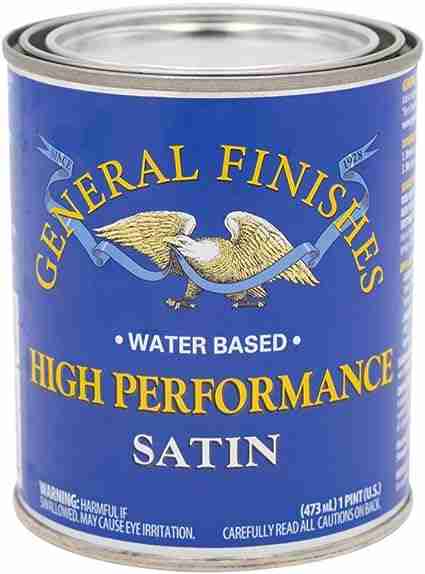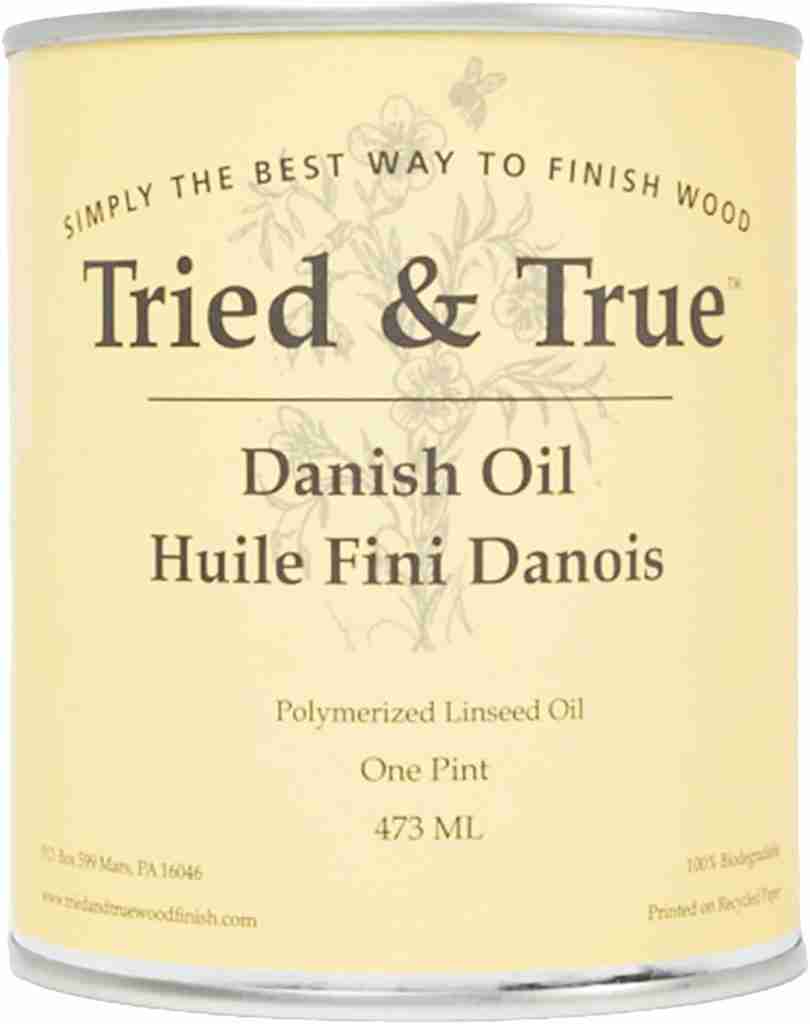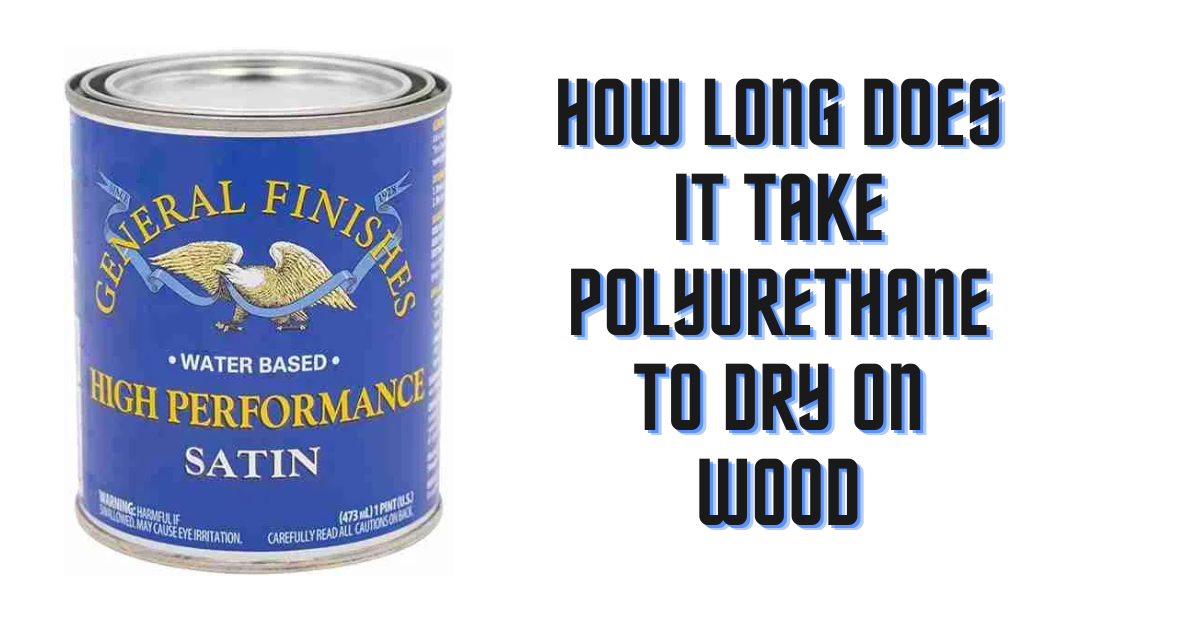You’ve just applied a fresh coat of polyurethane to your wooden surface, and the gleam in the finish reflects your satisfaction.
But now, a question lingers in your mind: “How long does it take for polyurethane to dry on wood
Understanding the drying time ensures that your wooden piece cures properly, maintaining its luster and durability.
In this guide, you’ll discover the factors that influence the drying time of polyurethane on wood and learn the best practices to follow, ensuring your masterpiece turns out just as you envisioned.

Your choice of polyurethane, whether it’s oil-based or water-based, the ambient temperature, humidity levels, and even the wood type can all play vital roles in the drying process.
Are you applying it in a well-ventilated area? How thick is the coat? You’ll find that the answers to these questions are key to unlocking the timing mystery.
Whether you’re a DIY enthusiast or a professional woodworker, knowing how to properly gauge the drying time is crucial to achieving that flawless finish.
Join us as we delve into the specifics, provide expert tips, and guide you through the waiting period, turning that seemingly simple question into a well-informed plan for your next wood project.
As you dive deeper into understanding how long it takes for polyurethane to dry on wood, a crucial piece of the puzzle lies in the type of polyurethane you’re using.
There’s a world of difference between oil-based and water-based polyurethane, both in their characteristics and their drying times. But it doesn’t stop there.
Within these categories, you also need to consider the finish – are you opting for high-gloss, semi-gloss, or satin? Each type comes with its own drying timeline and optimal conditions for curing.
In this section, we’ll unravel the intricacies of the different types of polyurethane, empowering you to make the right choice for your project and better estimate the drying time you can expect.
Types of Polyurethane
Water-Based Polyurethane as a Type of Polyurethane

You’ve made the decision to finish your wood project, and you’re exploring your options. Among the vast sea of choices, water-based polyurethane stands out as a prominent type of polyurethane.
But what exactly is it, and why might it be the right choice for your project? This comprehensive guide will explore the characteristics, advantages, applications, and tips for using water-based polyurethane, giving you all the knowledge you need to proceed with confidence.
What is Water-Based Polyurethane?
Water-based polyurethane is a clear finish used to coat wood surfaces. Unlike its oil-based counterpart, it offers a faster drying time and a more environmentally friendly profile. Here are some of its important features:
Drying Time: You’ll love the quick drying time of water-based polyurethane. Usually, it dries to the touch within hours, allowing you to add multiple coats in a single day.
Appearance: Offering a clear finish, water-based polyurethane won’t yellow over time, maintaining the natural beauty of your wood.
Odor: Less fumes and a milder odor make it more pleasant to work with, especially in confined spaces.
Clean-Up: Cleanup is a breeze with just soap and water.
Advantages of Water-Based Polyurethane
Water-based polyurethane’s benefits extend beyond aesthetics and convenience. Here are some of the reasons why it might be the best option for you:
Environmentally Friendly: With lower VOCs, it’s a greener option.
Versatility: Suitable for almost all wood types, water-based polyurethane is a versatile choice for furniture, flooring, and more.
Durability: Don’t be fooled by its thin consistency; water-based polyurethane offers a durable finish that resists wear and tear.
How to Apply Water-Based Polyurethane
You’re considering water-based polyurethane, but how do you apply it? Here’s a step-by-step guide:
- Prepare the Surface: Ensure it’s clean, dry, and sanded smoothly.
- Choose the Right Tools: Use a high-quality synthetic brush or a foam applicator.
- Apply Thin Coats: Several thin coats generally work better than one thick one.
- Allow Adequate Drying Time: Follow the manufacturer’s instructions for drying between coats.
- Sand Between Coats: A light sanding ensures proper adhesion.
- Finish with Care: Your last coat should be applied with attention to avoid brush marks.
Water-based polyurethane is more than just a finish; it’s a thoughtful choice that aligns with efficiency, aesthetics, and environmental consciousness.
Understanding its characteristics and proper application techniques empowers you to make the most of this versatile finish. Whether
Whether you’re a seasoned professional or a DIY hobbyist, water-based polyurethane could be the perfect option for your next wood project.
With this guide, you now have the insights needed to proceed with confidence, ensuring a beautiful and lasting result.
Oil-Based Polyurethane as a Type of Polyurethane

You’ve chosen a woodworking project, and now you’re faced with the decision of selecting the right finish. Among the options, oil-based polyurethane beckons with its rich luster and durable finish.
But what sets it apart from other polyurethane types? This detailed guide will uncover the characteristics, benefits, and application tips of oil-based polyurethane, providing you with the insight needed to make the right choice for your specific needs.
What is Oil-Based Polyurethane?
Oil-based polyurethane is a widely-used wood finish known for its resilient and glossy appearance. Here are some of its important features:
1. Drying Time: Unlike water-based options, oil-based polyurethane takes longer to dry, typically requiring overnight curing between coats.
2. Appearance: It enhances the wood’s natural color and often adds a slight amber tint, giving your project a warm, classic look.
3. Odor: Oil-based polyurethane emits stronger odors and requires good ventilation.
4. Clean-Up: Mineral spirits or paint thinner are needed for clean-up, as water and soap won’t suffice.
Advantages of Oil-Based Polyurethane
Oil-based polyurethane has been the go-to choice for many woodworkers for several reasons:
1. Durability: Known for its tough and long-lasting finish, it resists scratches, stains, and wear.
2. Depth of Finish: The rich and deep finish adds a luxurious touch to the wood, enhancing its natural beauty.
3. Value: Often more budget-friendly compared to water-based options, it offers great value for the money.
How to Apply Oil-Based Polyurethane
Ready to apply oil-based polyurethane?Here’s a step-by-step procedure for you:
- Prepare the Surface: Ensure the wood is sanded smoothly, clean, and free of dust.
- Choose the Right Tools: A natural-bristle brush or lambswool applicator works best.
- Apply in Even Coats: Work in well-ventilated areas and follow the grain of the wood.
- Allow Adequate Drying Time: Allow the recommended drying time between coats, often overnight.
- Sand Between Coats: Lightly sand to ensure proper adhesion.
- Finish Thoughtfully: The final coat should be applied carefully to achieve a flawless finish.
Oil-based polyurethane stands out as a timeless choice for those looking to achieve a rich and resilient finish. Its unique characteristics make it suitable for a wide range of projects, from furniture to hardwood floors.
By understanding its properties, advantages, and proper application techniques, you’re poised to make an informed decision that aligns with your project’s goals.
Embrace the elegance of oil-based polyurethane and transform your woodworking endeavor into a lasting masterpiece.
With this guide, you are well-equipped to succeed, creating a beautiful finish that will endure for years to come.
Unraveling the Factors Influencing Your Polyurethane Drying Time
Whether you’re a DIY enthusiast or a professional craftsman, understanding the factors influencing polyurethane drying time can be crucial to the outcome of your project.
Let’s delve into what exactly determines this drying time and how you can manipulate these factors to suit your requirements.
Temperature Plays a Crucial Role
Firstly, the ambient temperature in your workspace significantly impacts the drying time of polyurethane.
Generally, a warmer environment expedites the drying process. As a rule of thumb, aim for a room temperature of around 70°F.
Be aware that if your workspace is too hot or too cold, it could cause the polyurethane to dry unevenly or not at all.
Humidity: The Invisible Impact
Next, the humidity level in the air is another major player in polyurethane drying time. Higher levels of humidity slow down the drying process as they increase the amount of time it takes for the water in the polyurethane to evaporate. Aim for a humidity level of 50% or below for optimal drying conditions.
Type of Polyurethane Matters
The type of polyurethane you use also affects the drying time. Oil-based polyurethane tends to dry slower than water-based ones, due to its denser composition.
However, it generally provides a more robust and rich finish. Your choice between oil and water-based polyurethane will thus depend on your project’s requirements and the drying time you have in hand.
Application Thickness: More Isn’t Always Better
The thickness of your polyurethane application is another crucial factor. Thicker coats take longer to dry. For quicker drying time, you’re better off applying multiple thin coats rather than one thick one. This strategy also results in a smoother and more even finish.
Ventilation: Keep the Air Moving
Finally, proper ventilation aids in the drying process of polyurethane. Good air circulation enables solvent fumes to disperse and speeds up the drying process.
So, ensure that your workspace is well-ventilated, but beware of dust that could mar your finish.
Various factors like temperature, humidity, the type of polyurethane, application thickness, and ventilation influence the drying time of polyurethane.
By understanding and controlling these factors, you can ensure a smoother application process and achieve an immaculate finish.
Don’t forget, patience is key when working with polyurethane; rushing the process could compromise your results.
How Long Does it Take Polyurethane to Dry on Wood
Decoding the Drying Time: How Long Does Oil-Based Polyurethane Take to Dry on Wood?
In your journey as a DIY enthusiast or a professional craftsman, you’ve likely used oil-based polyurethane for sealing and protecting wooden surfaces.
“How long does oil-based polyurethane take to dry on wood?” becomes the major question. Let’s find out the answer and understand the elements that influence it, so you can manage your tasks more effectively.
Understanding Oil-Based Polyurethane Drying Time
Generally, oil-based polyurethane takes longer to dry than its water-based counterpart. On average, you can expect it to dry to the touch within 6-8 hours.
However, for a complete cure, it typically needs anywhere from 24 to 48 hours, depending on the ambient conditions and the specifics of the application.
The Temperature Factor
Temperature plays a significant role in the drying time of oil-based polyurethane. The ideal temperature for applying and drying polyurethane is around 70°F.
If the temperature drops, it could prolong the drying time. Similarly, an exceedingly hot environment could cause the polyurethane to dry too quickly, potentially leading to a less-than-ideal finish.
The Role of Humidity
Another key determinant is humidity. High humidity levels slow down the drying process as they prevent the quick evaporation of the polyurethane’s volatile components.
If you’re aiming for a quick drying time, it’s best to apply your oil-based polyurethane in an environment with 50% or less humidity.
Ventilation Matters
Your project’s drying time is also influenced by the ventilation in your workspace. Good air circulation helps to speed up the drying process by allowing solvent fumes to disperse.
Ensure your workspace is well-ventilated, but remember to protect your project from dust that could mar the finish.
Application Thickness and Your Drying Time
The thickness of your polyurethane application directly impacts the drying time. Thicker coats will take longer to dry than thinner ones.
Applying several thin coats instead of one heavy coat not only speeds up the drying process but also results in a more even, smoother finish.
Influence of the Wood Type
Lastly, the type of wood you’re working with can affect the drying time. Different woods absorb polyurethane at different rates, altering the drying time. Keep this in mind as you arrange your project’s timeline.
While oil-based polyurethane generally takes between 24-48 hours to fully cure, various factors like temperature, humidity, ventilation, application thickness, and wood type can influence this timing.
By understanding these factors, you can better plan your projects, ensuring a smooth application process and a high-quality finish that lasts.
npacking the Timeline: How Long Does Water-Based Polyurethane Take to Dry on Wood?
When you’re working with wood, the use of water-based polyurethane can offer a durable, clear finish that accentuates the natural beauty of the material.
But one question might be lingering in your mind: “How long does water-based polyurethane take to dry on wood? Let us address this essential subject and investigate the factors that influence drying time.
Navigating the Drying Time of Water-Based Polyurethane
Generally, water-based polyurethane dries faster than its oil-based counterpart. It usually dries to the touch in a matter of 1-2 hours and reaches a full cure in approximately 24 hours.
However, this timeline can vary based on factors like temperature, humidity, the thickness of application, and ventilation.
The Impact of Temperature
Temperature is a crucial factor influencing the drying time of water-based polyurethane. The ideal temperature for application and drying is around 70°F. Lower temperatures can slow down the drying process, while excessively high temperatures may cause the finish to dry too quickly, possibly leading to a subpar finish.
Humidity’s Role in Drying Time
Humidity also plays a substantial role in the drying time. High humidity slows down the drying process as it reduces the evaporation rate of water in the polyurethane.
If a speedy drying time is your goal, you should apply water-based polyurethane in a low humidity environment, ideally below 50%.
Why Ventilation is Important
Ventilation in your workspace is another crucial aspect. Good air circulation speeds up the drying process by helping to dissipate water vapor from the polyurethane.
Ensure that your workspace is well-ventilated, but be careful to prevent dust from settling on your project during the drying phase.
The Thickness of Application Matters
The thickness of your polyurethane application directly influences drying time. Thicker coats dry slower than thinner ones.
To accelerate the drying process and achieve a smoother finish, consider applying multiple thin coats instead of a single thick one.
The Kind of Wood Can Make a Difference
Finally, the type of wood you’re working with can impact the drying time. Different wood types absorb water-based polyurethane at varying rates, which can alter the drying time. Keep this in mind when you plan your projects.
Water-based polyurethane typically takes about 24 hours to fully cure on wood, although this can change based on factors like temperature, humidity, application thickness, ventilation, and the type of wood. By understanding these variables, you can better plan your project timelines and ensure a beautiful, durable finish.
Conclusion – How Long Does it Take Polyurethane to Dry on Wood
The drying time of polyurethane on wood depends on a multitude of factors like the type of polyurethane you use, the temperature, humidity levels, and the type of wood itself.
While oil-based polyurethane might require 24-48 hours, water-based ones usually dry faster, within 2-4 hours. Remember to ensure the ideal conditions: moderate temperature and low humidity, for the best results.
Apply thin coats and give each layer ample time to dry to get that flawless finish you’re aiming for. It might seem like a lengthy process, but patience is key here.
With the right approach, your woodwork will not only look stunning but will also last for years to come.
Keep experimenting and learning from every application, and you’ll become a pro at using polyurethane on wood in no time.
Important Reads:

